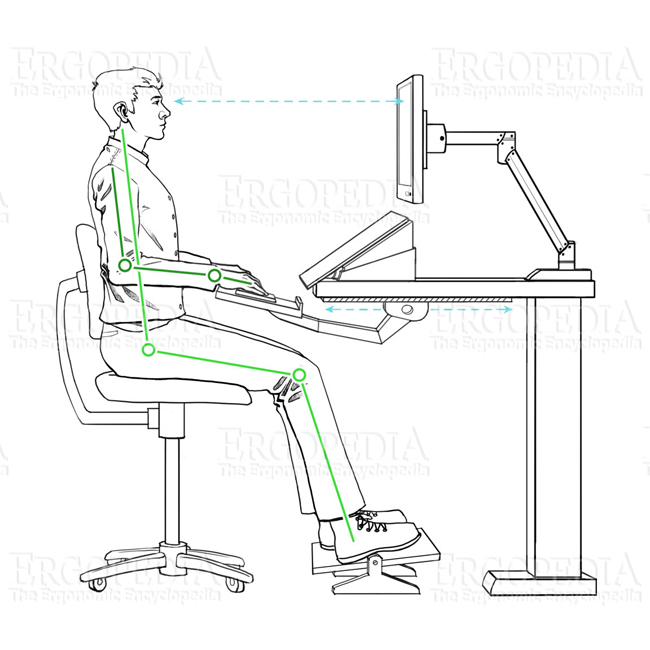 Improper
Work Surface Height
Improper
Work Surface Height
*** Please note this
page has been updated and moved to http://www.ergopedia.ca/risk_factors/Incorrect_Worksurface_Height.html
***
What is an Improper Work Surface
Height?
The primary work surface (where the keyboard and mouse are
located) should be just above the legs of the user with a
neutral or slightly negative inclination. This should result in
forearms (and hands) which are parallel to the ground or
slightly negative while working. It is very important to have
both keyboard and mouse on the same work surface and at the same
height as there is only one comfortable height when seated in an
relaxed posture.
Why is Improper Work Surface Height a Risk Factor?
If the worksurface is too high, the user is forced to raise
their arms and/or shoulders. This puts a 'static load' on the
muscles since they are required to be constantly engaged to
maintain position. In addition, the underside of the
forearm or wrist will experience a compression point wherever
they press against the edge of the worksurface. Finally,
the wrist may have to flex (i.e. bend forward) to perform
required tasks (keyboarding / mousing) placing additional stress
on the forearm and wrist.
If the worksurface is too low, the user is forced to lean
forward, which can cause back strain and stress to the arms in
attempting to perform tasks. In addition, the wrists will
be forced to be in a position of
Wrist
Extension (i.e. be bent upward) in order to perform
keyboarding and mousing tasks.
How Specific a Height does a Work Surface have to be to avoid
it being a Risk Factor?
There is a very low level of tolerance in the wrist for most
individuals and anything more than 1" higher or 2" lower than
the ideal would represent a risk factor. This applies to
both sitting and standing workstations.
What are the Symptoms of a Work Surface which is 'Too High' or
'Too Low'?
Symptoms that indicate that the worksurface is at an improper
height are strain in the arms, shoulders, wrists and back.
How can the Choice of Workstation Help to Reduce Improper
Work Surface Height?
Most standard desks have a height of 29" which is too high for
most individuals under 5'11" in height.
Articulating
Keyboard Arms will allow a keyboard tray to be
adjusted downwards to the desired height to allow the elbow to
be higher than the wrist when the upper arms are at rest at the
sides. Another alternative is to replace the desk with an
Adjustable
or Sit Stand Workstation which will adjust not only
a small keyboard tray but also adjust an entire desktop to the
ideal height, for sitting, standing, and all positions in
between.
What Other Strategies can be used to Address Work Surface
Height?
There are various other strategies to address this issue.
By raising the height of the chair seat, the proper relative
height at the arm can be achieved but there may be a requirement
to add a
Foot
Rest to prevent dangling of the feet. If a
worksurface needs to be adjusted upwards, there are risers
available which will raise the worksurface by various means.

 Improper
Work Surface Height
Improper
Work Surface Height